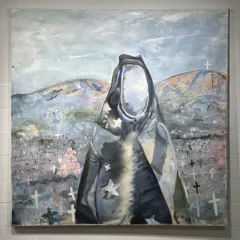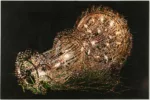Emmet Gowin, the catalog accompanying a retrospective now touring in Spain, is a great introduction to the artist’s works and a great keepsake for a fan. The writings by Keith Davis, Carlos Gollonet and Gowin himself identify the photographer’s humanist and spiritual roots and detail his journey from 1960’s-era people pictures focused on his wife, Edith and family in Danville, VA, to aerial photographs of ravaged landscapes, like the nuclear test grounds in Nevada, and his most recent project archiving tropical, nocturnal-moths.


While his disparate bodies of work may look like geologic shifts in subject matter, Gowin talks in the book about the spiritual quest he’s on, and his realization that humankind inhabits the land, and that the land is a vital part of who we are. To my eye, what holds all the works together is Gowin’s never-ceasing focus on non-conventional beauty. His way of photographing both people and the wasted landscapes plays up the dark sublime. These are not traditional pretty pictures, but they are exquisitely beautiful. All Gowin photos smolder with emotion and feel like they were snapped with a breath held, bated with desire.
I’ve seen Gowin’s works most recently at his mini-survey exhibit at Swarthmore College’s List Gallery (see review). If you missed that excellent show, this book allows you to spend personal time, one-on-one, with 181 works you want to come back to again and again. The essays by Carlos Gollonet and Keith F. Davis are heartfelt and have the same bated-breath ambiance of Gowin’s photos. Bravo to Fundacion Mapfre and Aperture Foundation for producing this gorgeous book.
Emmet Gowin, Fundacion Mapfre, Madrid in association with Aperture Foundation, New York, 2013 255 pages, Hardback, $65 www.aperture.org. Exhibition at Fundacion Mapfre, May 29-Sept. 1, 2013 and at Sala Rekalde, Bilbao, Oct. 24, 2013-Jan. 29, 2014
How we sit together

Francis Cape’s utopian benches, which we sat on at Arcadia University last year, stirred dreams of communal living, peace, concord and utopias, both large and imagined and small and earthly. The new book by Cape, We Sit Together: Utopian Benches from the Shakers to the Separatists of Zoar, with essays by Richard Torchia, gallery director at Arcadia, and copious research notes by the artist about the utopian communities, extends the life of the exhibit and gives a reader a great introduction to the idea of utopianism, as well as a short history of its practice up to and including current day.
The book, published by Princeton Architectural Press, has some great color photos from the Arcadia installations, lots of black and white photos of the community buildings and the original benches. While this is not in the least intended as a how-to book, Cape has included carpenters’ schematics for the benches, in case someone gets ambitious to build a bench herself. For a lay reader with no carpentry skills, the drawings are great to look at and they communicate the simplicity and elegance of the designs. I can’t help but compare the plans for these sturdy benches with Ikea’s clunky “how to” schematics, and the idea behind the produce, that the mass-produced, particle-board product you are struggling to assemble will most likely wind up in the landfill, so little is your commitment to it. How dystopian is that?
Read artblog’s feature story on the show at Arcadia.
We Sit Together: Utopian Benches from the Shakers to the Separatists of Zoar, by Francis Cape. 2013, Princeton Architectural Press, New York. Paperback, $24.95 www.papress.com










